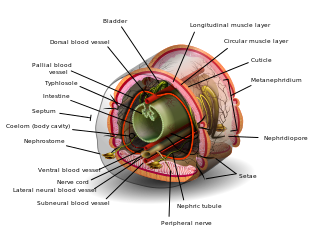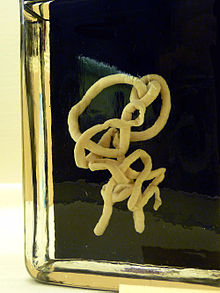
The Sipuncula or Sipunculida is a class containing about 162 species of unsegmented marine annelid worms. The name Sipuncula is from the genus name Sipunculus, and comes from the Latin siphunculus meaning a "small tube".

Acanthocephala is a group of parasitic worms known as acanthocephalans, thorny-headed worms, or spiny-headed worms, characterized by the presence of an eversible proboscis, armed with spines, which it uses to pierce and hold the gut wall of its host. Acanthocephalans have complex life cycles, involving at least two hosts, which may include invertebrates, fish, amphibians, birds, and mammals. About 1420 species have been described.

Nemertea is a phylum of animals also known as ribbon worms or proboscis worms, consisting of 1300 known species. Most ribbon worms are very slim, usually only a few millimeters wide, although a few have relatively short but wide bodies. Many have patterns of yellow, orange, red and green coloration. The foregut, stomach and intestine run a little below the midline of the body, the anus is at the tip of the tail, and the mouth is under the front. A little above the gut is the rhynchocoel, a cavity which mostly runs above the midline and ends a little short of the rear of the body. All species have a proboscis which lies in the rhynchocoel when inactive but everts to emerge just above the mouth to capture the animal's prey with venom. A highly extensible muscle in the back of the rhynchocoel pulls the proboscis in when an attack ends. A few species with stubby bodies filter feed and have suckers at the front and back ends, with which they attach to a host.

The coelom is the main body cavity in most animals and is positioned inside the body to surround and contain the digestive tract and other organs. In some animals, it is lined with mesothelium. In other animals, such as molluscs, it remains undifferentiated. In the past, and for practical purposes, coelom characteristics have been used to classify bilaterian animal phyla into informal groups.

Amiskwia is a genus of soft-bodied animals known from fossils of the Middle Cambrian Lagerstätten both in the Burgess Shale in British Columbia, Canada and the Maotianshan shales of Yunnan Province, China. It is interpreted as a member of the clade Gnathifera sensu lato.

Oligochaeta is a subclass of animals in the phylum Annelida, which is made up of many types of aquatic and terrestrial worms, including all of the various earthworms. Specifically, oligochaetes comprise the terrestrial megadrile earthworms, and freshwater or semiterrestrial microdrile forms, including the tubificids, pot worms and ice worms (Enchytraeidae), blackworms (Lumbriculidae) and several interstitial marine worms.

The bootlace worm is a species of ribbon worm and one of the longest known animals, with specimens up to 55 m (180 ft) long being reported, although this has not been confirmed. Its mucus is highly toxic.

Palaeonemertea is a class of primitive nemertean worm. It may be para- or polyphyletic, consisting of three to five clades and totalling about 100 species.

Heteronemertea is a monophyletic order of about 500 species of nemertean worm. It contains genera such as Lineus and Cerebratulus, and includes the largest and most muscular nemerteans.

Enopla is one of the classes of the worm phylum Nemertea, characterized by the presence of a peculiar armature of spines or plates in the proboscis.

Geoplanidae is a family of flatworms known commonly as land planarians or land flatworms.

An earthworm is a soil-dwelling terrestrial invertebrate that belongs to the phylum Annelida. The term is the common name for the largest members of the class Oligochaeta. In classical systems, they were in the order of Opisthopora since the male pores opened posterior to the female pores, although the internal male segments are anterior to the female. Theoretical cladistic studies have placed them in the suborder Lumbricina of the order Haplotaxida, but this may change. Other slang names for earthworms include "dew-worm", "rainworm", "nightcrawler", and "angleworm". Larger terrestrial earthworms are also called megadriles as opposed to the microdriles in the semiaquatic families Tubificidae, Lumbricidae and Enchytraeidae. The megadriles are characterized by a distinct clitellum and a vascular system with true capillaries.

The nematodesroundworms or eelworms, constitute the phylum Nematoda. They are a diverse animal phylum inhabiting a broad range of environments. Most species are free-living, feeding on microorganisms, but there are many that are parasitic. The parasitic worms (helminths) are the cause of soil-transmitted helminthiases.

Parborlasia corrugatus is a proboscis worm in the family Cerebratulidae. This species of proboscis or ribbon worm can grow to 2 metres in length, and lives in marine environments down to 3,590 metres (11,780 ft). This scavenger and predator is widely distributed in cold southern oceans.
Prostoma jenningsi is a species of ribbon worm known only from one site near Croston, Lancashire. It was described in 1971, and is believed to be the county's only endemic species. It grows up to 20 mm (0.8 in) long, with 4–6 black eyespots, and has a long eversible proboscis.

Malacobdellidae is a monogeneric family within the phylum Nemertea. It is included with the order Hoplonemertea within the class Enopla.

The annelids, also known as the segmented worms, are a large phylum, with over 22,000 extant species including ragworms, earthworms, and leeches. The species exist in and have adapted to various ecologies – some in marine environments as distinct as tidal zones and hydrothermal vents, others in fresh water, and yet others in moist terrestrial environments.

Gorgonorhynchus repens is a species of the proboscis worm in the subclass Heteronemertea and of the family Gorgonorhynchidae. It is to be found on the seabed in shallow water in the Pacific Ocean.
Ikeda taenioides is a species of spoon worm in the family Ikedidae. It is native to the northern Pacific Ocean where it is found in the subtidal waters around Japan.
Hoplonemertea is an order of ribbon worms in the class Enopla. It contains two suborders:
















